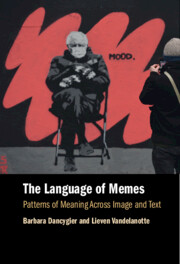Book contents
- The Language of Memes
- The Language of Memes
- Copyright page
- Dedication
- Contents
- Figures
- Tables
- Acknowledgements
- Abbreviations
- 1 Why Study Memes from the Linguistic Perspective?
- 2 Memes and Multimodal Figuration
- 3 Image Macro Memes
- 4 Labelling Memes
- 5 Memetic Grids
- 6 Memetic Use of Personal Pronouns
- 7 Say, Tell, and Be Like Meme Constructions
- 8 Embedding Discourse Spaces without Say Verbs
- 9 Memetic Form and Memetic Meaning
- 10 Memetic Discourse on Social Media Platforms
- 11 Memes and Advertising
- 12 One Does Not Simply Draw a Conclusion
- References
- Index
3 - Image Macro Memes
Published online by Cambridge University Press: 12 September 2025
- The Language of Memes
- The Language of Memes
- Copyright page
- Dedication
- Contents
- Figures
- Tables
- Acknowledgements
- Abbreviations
- 1 Why Study Memes from the Linguistic Perspective?
- 2 Memes and Multimodal Figuration
- 3 Image Macro Memes
- 4 Labelling Memes
- 5 Memetic Grids
- 6 Memetic Use of Personal Pronouns
- 7 Say, Tell, and Be Like Meme Constructions
- 8 Embedding Discourse Spaces without Say Verbs
- 9 Memetic Form and Memetic Meaning
- 10 Memetic Discourse on Social Media Platforms
- 11 Memes and Advertising
- 12 One Does Not Simply Draw a Conclusion
- References
- Index
Summary
This chapter introduces the distinction between entrenched images or Image Macros (IMs) and Non-Entrenched Images (NEIs), and focuses most of its discussion on examples involving IMs that feature the characteristic ‘Top Text’ (TT) and ‘Bottom Text’ (BT), such as the One Does Not Simply and Good Girl Gina memes (ODNS and GGG). It shows how these IM memes allow Meme Makers to categorize experiences very quickly, efficiently and (if successful) humorously, adding further examples to such categories as ‘futile undertakings that are impossible to achieve’ (ODNS) or ‘virtuous behaviour of highly considerate women’ (GGG), thanks in large part to the frames evoked visually. It also discusses aspects of the construction grammar approach to language, as applicable to these meme constructions, including specific constructional properties of GGG memes and the constructional networks they fit into.
Keywords
Information
- Type
- Chapter
- Information
- The Language of MemesPatterns of Meaning Across Image and Text, pp. 26 - 42Publisher: Cambridge University PressPrint publication year: 2025
Accessibility standard: WCAG 2.1 AA
Why this information is here
This section outlines the accessibility features of this content - including support for screen readers, full keyboard navigation and high-contrast display options. This may not be relevant for you.Accessibility Information
Content Navigation
Allows you to navigate directly to chapters, sections, or non‐text items through a linked table of contents, reducing the need for extensive scrolling.
Provides an interactive index, letting you go straight to where a term or subject appears in the text without manual searching.
Reading Order & Textual Equivalents
You will encounter all content (including footnotes, captions, etc.) in a clear, sequential flow, making it easier to follow with assistive tools like screen readers.
You get concise descriptions (for images, charts, or media clips), ensuring you do not miss crucial information when visual or audio elements are not accessible.
Visual Accessibility
You will still understand key ideas or prompts without relying solely on colour, which is especially helpful if you have colour vision deficiencies.
Structural and Technical Features
You gain clarity from ARIA (Accessible Rich Internet Applications) roles and attributes, as they help assistive technologies interpret how each part of the content functions.
